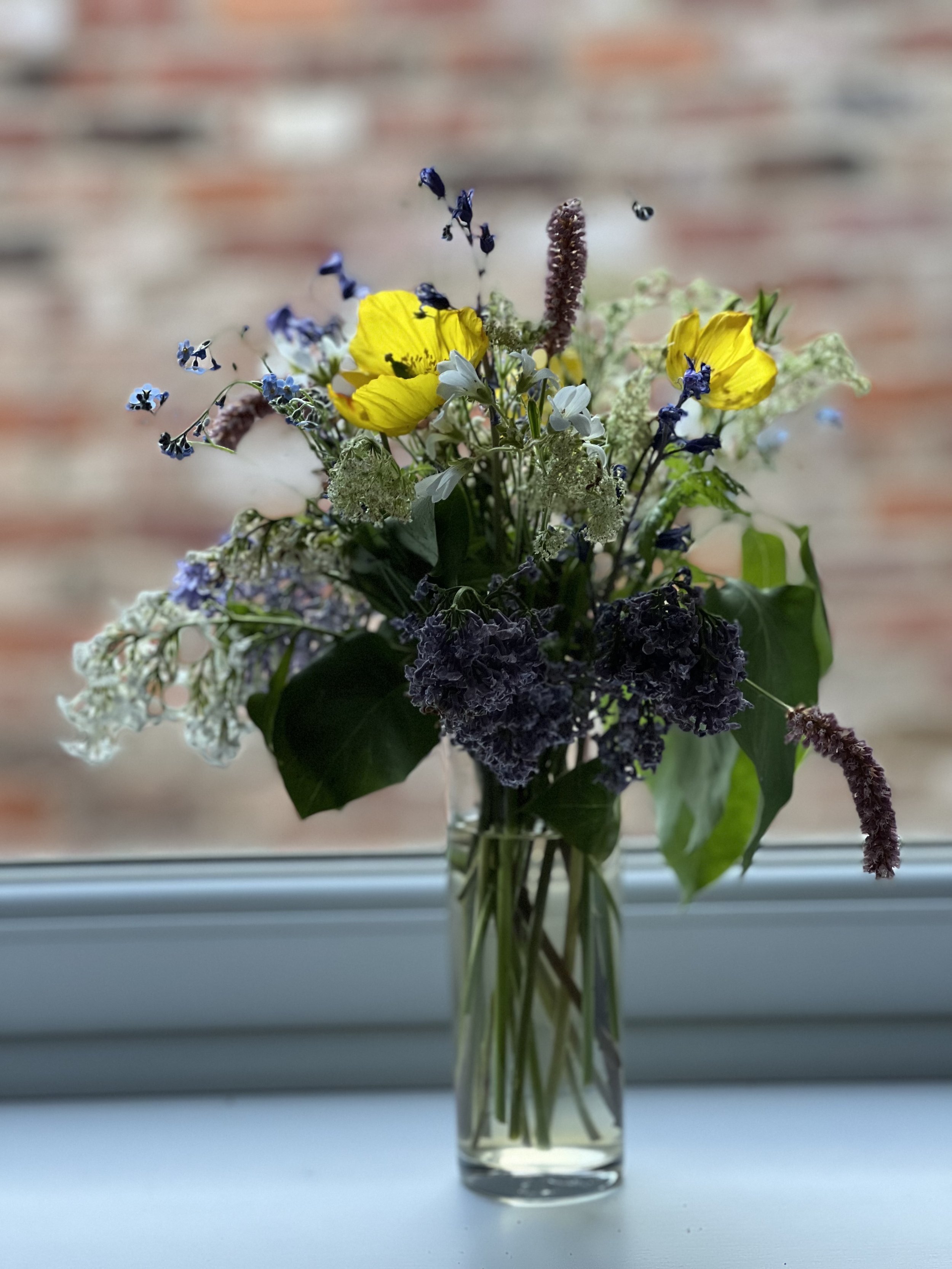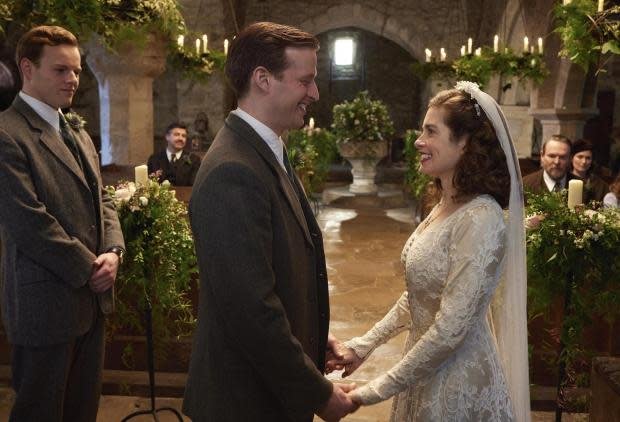Over Hill and Dale
“Over hill, over dale,
Thorough bush, thorough brier,
Over park, over pale,
Thorough flood, thorough fire,
I do wander every where,
Swifter than the moon’s sphere;
And I serve the fairy queen,
To dew her orbs upon the green:
The cowslips tall her pensioners be;
In their gold coats spots you see;
Those be rubies, fairy favours,
In those freckles live their savours:
I must go seek some dew-drops here
And hang a pearl in every cowslip’s ear.
Farewell, thou lob of spirits: I’ll be gone;
Our queen and all her elves come here anon.”
Monday (May 29) we went on an epic quest—a quest to find some of the more obscure and far-flung places in the Yorkshire Dales, a chance to see the Dales in all their rugged glory. We’re excited to share what we found!
Bad Intel
We started inauspiciously after reading some incorrect information.
You may be surprised to learn that not everything you read on the internet is true. This turned out to be the case with St Wilfrid’s Church in Burnsall.
Someone identified the church as where they filmed James and Helen’s wedding. Given its close proximity to Grassington, the wooden gatehouse at the entrance, the interior stone pillars in the middle of the pews, and the style of candelabras—it could be mistaken for the church. However, as we looked around, things just didn’t match up.
Another Google search suggested that two sites were used in fact. The one for the exterior was in the village of Arncliffe and the dramatic interior could be found in Hubberholme.
Carry on then…
St Wilfrid’s Church in Burnsall…not in any way associated with the filming of All Creatures Great and Small.
Malham Tarn Road
From Malham, we drove up the steeply inclining Tarn Road (a tarn is a lake; the name is linked to the old Norse word tjörn meaning pond—Viking influence is everywhere once you start paying attention).
At the top of the grade you reach the broad Malham Moor. It is at this rural intersection that James inadvertently got off the bus, forcing him to walk the remainder of the way to Darrowby.
From the Malham Moor intersection we passed Malham Tarn, where the couple stopped briefly, staring across the sparkling waters, before continuing on to their honeymoon.
Continuing on, we climbed out of a deep glacial valley and traversed a cliffside, before dropping down dramatically into the quaint village of Arncliffe.
Arncliffe
Arncliffe rests idyllically at the bottom of a deep ancient glacial valley, with hillsides rising strikingly on two sides and the tranquil River Shirfare wending its way through the basin.
In the world of All Creatures Great and Small, it is known for four filming locations.
The charming Falcon Inn was used as the Drover’s Inn pub in the original BBC TV series version of the show.
The pub has a pretty charming and festive interior. At another time, we might have stopped for a pint. Of course, on a nice day such as this, all the patrons were seated outside.
At this point in the day, we really just needed the Inn for one reason—the loo. This is the sign from inside the women’s toilet. Everything is as you might expect—until you get to the last item not to flush. Is that a thing? Do people do that? Only in Britain!
The surgery in Grassington did not have the back garden they wanted for filming, so the 2020 show uses a property here in Arncliffe for all the scenes at the back of the house. (We behaved ourselves and didn't go poking around houses to see which was the house.)
Arncliffe also has this beautiful, large green in the center of town. This was used for filming the bus stop scenes.
Finally, we get to the primary reason for visiting Arncliffe, St Oswald’s Church. After our first misadventure at St Wilfrid’s Church in Burnsall, we found the correct church where they filmed the exterior shots for James and Helen’s wedding in Season 3, Episode 1. (Never mind the old stocks still sitting outside the parish church—just focus on the pretty Queen Anne’s Lace.)
This wonderful wooden gateway made a picturesque backdrop for Helen as her father walked her to the church.
Another specific angle seen as Helen and her father approach the church.
The spot where the newlyweds exit the church, framed by the wedding party on either side.
The amazing Yew trees framing the walkway where the newlyweds headed to their car.
Lilac
Amanda made her own bouquet from the wild flowers in the churchyard.
Amanda’s bouquet on our window ledge in our apartment.
Don’t hurt yourself trying to read this, I just loved the shape and the moss.
As far as days in the Yorkshire Dales go, Monday was magnificent. Best not waste such moments. We laid out the blanket, set up the camp chair, and read books under the pleasant sun, amongst the gentle reminders that our time here is a mist, destined to vanish.
Hubberholme
Setting cathedrals aside, we have had the good fortune to visit many smaller churches throughout our travels.
Some of these rest on large estates and were built for the landowners, but most are parish churches. With very few exceptions, all remain open and welcome visitors inside at any time.
Many of these churches were quite beautiful, but the interior of St Michael and All Angels Church in Hubberholme jumped to the front of the queue the moment we entered.
It is spectacular! The church building is mainly 12th century, built upon the site of an old forest chapel.
The masonry work throughout the church is wonderful. From the thick exterior walls, to the quirky asymmetrical archways on either side of the central aisle, to the floors, to the baptismal font—the stonework is the defining feature that gives the space such a special feel.
(The church was extended to the north (left in the photo above) in the 16th century, which probably explains the simple rounded archways on the right and the more modern pointed arches to the left.)
Sunlight enters the church through stained glass windows deeply set into the stone exterior walls and candelabras placed widely throughout the space use real candles. It is easy to imagine the space in the evening with only the glow of candlelight flickering along the stone walls—so “dark academia.”
From the ornate ceiling, to the entrance door (above), to the pulpit, to the pews, to the chancel screen—the woodwork is simply beautiful.
However, the woodwork item that makes this church truly exceptional is the beautiful Rood Loft, which has survived when nearly all others were destroyed or have long since decayed.
Before the Reformation the focal point of all churches, even small ones, was the Holy Rood; a great crucifix that stood high above the congregation upon the Rood Beam over the chancel. (Reminds me of Palace of Holyroodhouse in Edinburgh.) The cross was often accompanied by figures of Mary and John, where candles were kept burning, paid for by the many bequests for “the light to burn before the Rood.”
Access to the beam was by way of the Rood Loft, usually an ornately carved and painted structure set just above the Rood Screen beneath the chancel arch. On occasion the priest would preach from the loft, lit by the candles about the Rood, the added height and position providing extra impact to his sermons.
Protestants regarded them as Popish idolatry and it was during the Elizabethan Injunctions that irreversible damage occurred when anything connected with the old religion was ripped out and burnt on huge bonfires. With the Roods and Rood figures gone, the loft itself had little use and in the following years most of them slowly decayed until they were removed altogether.
While the Rood itself is now gone, the rood loft is one of only a few remaining in all of Britain, so it was an honor to see this rare rood loft in person.
The extraordinary Rood Loft seen above Amanda
They of course decorated the church beautifully for the wedding of James Herriot and Helen Alderson, but even unadorned this church is filled with character.
Where Siegfried and Mrs Hall sat during the ceremony.
Alderson Farm
Helen is a Yorkshire Dales farmer’s daughter who’s not afraid to get her hands dirty. Capable and fiercely independent, a lover of animals and the great outdoors, she captures the attention of James early on.
This is the farm used as the Alderson farm on All Creatures Great and Small. It is located in Yockenthwaite, a hamlet in the Langstrothdale Valley.
Helen lives on the farm with her father Richard and younger sister Jenny.
The old stone bridge over the River Wharfe leading to the farm.
Such a beautiful valley.
The Green Dragon Inn
The Green Dragon was used for the interior shots of the Drover’s Inn in All Creatures Great and Small. In The Hobbit, The Green Dragon Inn was frequented by Hobbits from Bywater.
When you read comments about the pub, people say it is one of the most atmospheric in England. So when we went to the website and read the message they were closed until further notice, we were devastated!
From their website, “Unfortunately due to the current economic situation and the steep rise in energy costs, The Green Dragon Inn is closed until further notice.”
Undeterred, we decided to go anyway and just peek into the windows like a couple of creepers.
As we neared the Inn we were shocked to see people sitting at tables in front of the building…and the front door was open!
In the Uk, the last Monday in May was once Whit Monday or Pentecost Monday and later became “Spring Bank Holiday.” This is the same weekend as our Memorial Day. The pub owners had decided to launch a soft re-opening in conjunction with the Spring Bank Holiday, with cash only and “wet sales only” (meaning beer only, no food).
We both had to pause and take stock of our very good fortune in visiting when we did.
The pub is ancient, dating from 13th century, with flagged floors, open fires, beamed ceilings, and stone walls. In every way possible, it lived up to our expectations! Above is the very bar when Mr Farnon ordered pints in Episode 1!
A pub of this caliber is a rare find; you really are stepping back in time. We did our best to soak in the atmosphere.
♥️♥️♥️
Here is a compilation video of our tour: https://www.youtube.com/watch?v=jYXmYQQ72sQ
Buttertubs Pass
Our final destination lay right around the corner from the pub, one last steep climb out of a Yorkshire dale and over a Yorkshire hill.
The view on the road heading up toward Buttertubs Pass.
Gorgeous!
Just over the summit at Buttertub Pass looking down into the Swaledale valley.
A grade sign you won’t see in the US. Yikes!
The day was a huge success, one of our favorites so far.















































